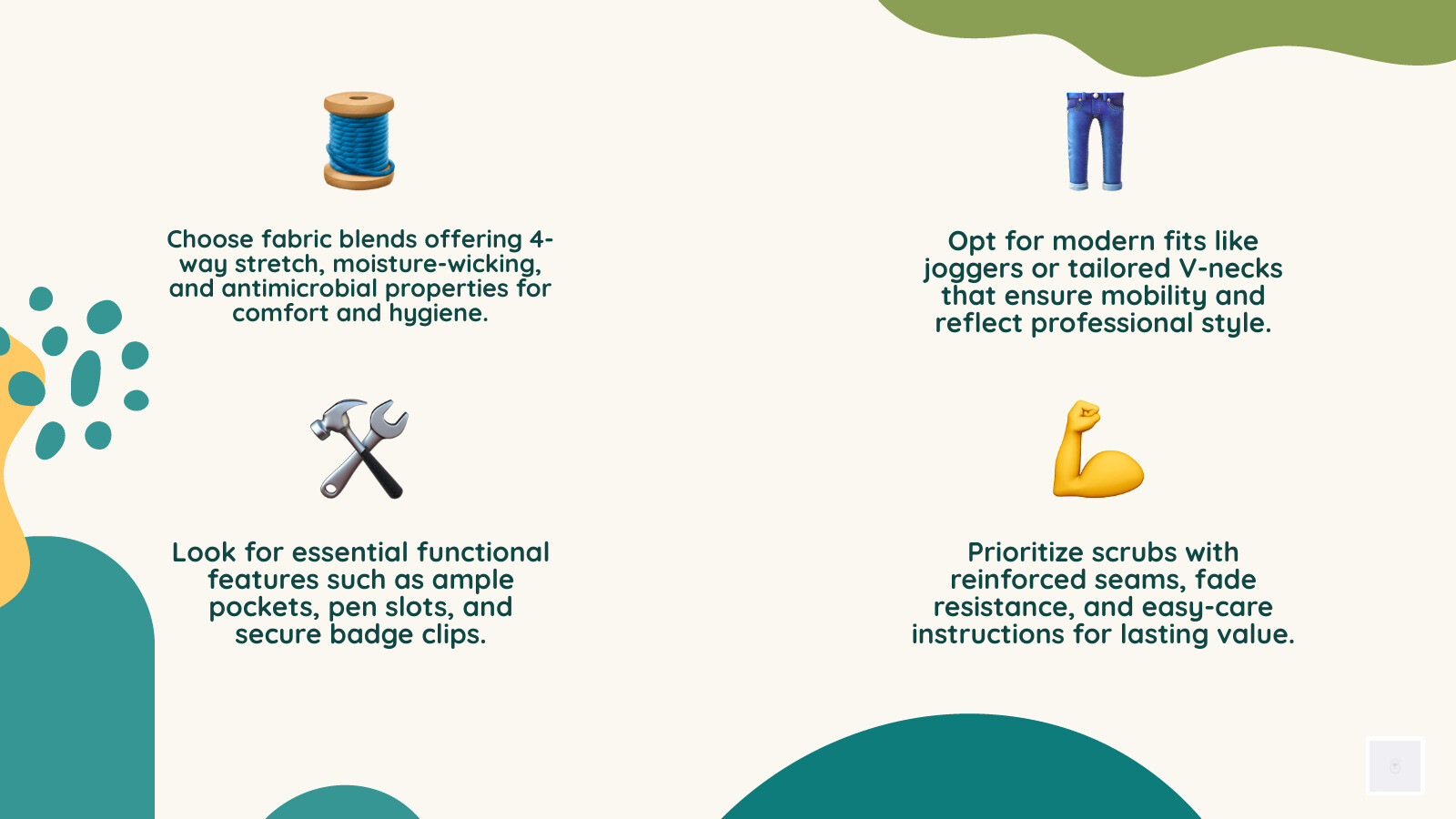Key Features to Consider When Choosing Medical Scrubs

For healthcare professionals, a shift can be long and demanding. Every day, you face unique challenges. Your uniform should support you, not hinder you. Medical scrubs are much more than just a piece of clothing. They are a critical part of your daily work. They impact your comfort, ability to move freely, and overall performance.
Over the years, medical scrubs have changed a lot. They are no longer just basic, boxy garments. Today’s scrubs combine advanced fabrics with smart designs, meeting the high demands of the healthcare environment.
In this extensive guide, we will explore everything about medical scrubs. We will look at top brands and the key features to consider. We will cover fabric technology, fit, and functionality. We will also discuss the latest fashion trends and how scrubs cater to different roles. We recommend this comprehensive medical scrubs guide if you’re looking for an even more in-depth resource.
We aim to help you make informed choices. This will ensure your scrubs truly support your vital work.

Choosing the right medical scrubs is a critical decision that impacts your daily comfort, performance, and overall well-being. It’s not just about picking a color or a size; it’s about understanding the intricate details of material science, fit, and functional design that contribute to a superior garment. Healthcare demands a lot from its professionals, and your attire should rise to meet those demands, not add to your discomfort. Many healthcare professionals report common complaints about their scrubs, such as stiffness, lack of breathability, poor fit that restricts movement, and fabrics that quickly fade or pill. Addressing these issues begins with a thoughtful selection process focused on key features.
Fabric Technology: The Foundation of Comfort and Performance
Fabric is arguably the most crucial element of a medical scrub. Modern scrub manufacturers leverage advanced textile technologies to create materials that are not only comfortable but also highly functional. The most common fabric blends typically combine synthetic and natural fibers to achieve a balance of desired properties.
- Cotton: Known for its softness and breathability, cotton offers excellent comfort, especially in warmer environments. However, 100% cotton can wrinkle easily and may not be as durable or quick-drying as blends.
- Polyester: A synthetic fiber, polyester brings durability, wrinkle resistance, and color retention. It’s often used to give scrubs a crisp, professional look and to help them withstand frequent washing.
- Rayon: Derived from wood pulp, rayon provides a silky, soft feel and drapes well, adding a luxurious touch to scrubs. It improves comfort and flexibility.
- Spandex (or Elastane/Lycra): This elastic fiber is the secret behind “stretch” scrubs. Even a small percentage of spandex (typically 2-5%) allows for significant 4-way stretch, providing unparalleled freedom of movement, which is essential for bending, lifting, and reaching throughout a busy shift.
Beyond elemental composition, look for specific fabric technologies that improve performance:
- Moisture-Wicking: Fabrics treated with moisture-wicking properties draw sweat away from the skin to the fabric’s outer surface, where it can evaporate quickly. This keeps you dry and comfortable, preventing that clammy feeling during long, strenuous shifts or in non-air-conditioned environments.
- Antimicrobial Properties: Some scrubs are infused with agents that inhibit the growth of bacteria, reducing odors and helping to maintain freshness. While not a substitute for proper hygiene, this feature can contribute to a more sanitary and pleasant work environment.
- Stain Resistance: Given the nature of healthcare work, stain resistance is a highly valued feature. Fabrics treated to repel liquids and resist stains make clean-up easier and help prolong the professional appearance of your scrubs.
- Breathability: Good breathability prevents overheating, even with synthetic blends. Look for fabrics with weaves that allow air circulation.
- Durability: Scrubs endure constant wear and tear, plus frequent high-temperature washing. Durable fabrics and reinforced stitching are essential for longevity, ensuring your investment lasts.
Brands like Cherokee, Barco, and Healing Hands are known for their innovative fabric technologies, which address these needs and offer solutions that combine comfort, stretch, and durability.
Fit and Sizing: Ensuring All-Day Comfort and Mobility
The fit of your scrubs is just as important as the fabric. An ill-fitting scrub can restrict movement, cause chafing, or look unprofessional. Scrub design has evolved far beyond the generic, boxy uniform, offering a variety of cuts and styles to suit different body types and preferences.
- Athletic Fit: Designed for a more streamlined look, athletic fit scrubs often feature tapered legs and a more custom top, providing a modern silhouette without sacrificing mobility due to stretch fabrics.
- Classic Fit: These offer a more relaxed, traditional cut, providing ample room for movement. While less form-fitting, modern classic fits still incorporate improved fabrics for comfort.
- Unisex Sizing: While still available, many brands are moving towards gender-specific cuts. Unisex sizing can sometimes lead to a less custom fit for both men and women, so consider trying them on if possible.
- Gender-Specific Cuts: Women’s scrubs often feature contoured seams, varied necklines (like V-neck or mock wrap), and more flattering shapes. Men’s scrubs typically offer broader shoulders, longer torsos, and different pant rises, designed to provide a better fit for the male physique.
- Petite and Tall Options: Petite and tall lengths in scrub pants are crucial for those who fall outside average height ranges, preventing tripping hazards or exposing ankles.
- Jogger Pants: A highly popular trend, jogger scrub pants feature an elasticized ankle cuff, offering a modern, athletic look and preventing pants from dragging on the floor.
- Straight-Leg Pants: A timeless and comfortable option, straight-leg pants provide a relaxed fit from hip to ankle.
- V-neck Tops: The most common and practical neckline, offering ease of wear and a professional appearance.
- Mock Wrap Tops: These tops create a flattering, styled look, often with a crossover front that mimics a wrap style.
When choosing, always consult sizing guides, and remember that personal preference for comfort and style plays a significant role. Brands like Maevn and Med Couture offer a wide range of sizing and style options to ensure a comfortable and professional look for everyone.
Functional Design: Pockets, Loops, and Durability
Beyond fabric and fit, scrubs’ practical design elements are paramount for healthcare professionals who need quick access to tools and supplies.
- Pocket Placement and Quantity: Pockets are invaluable. Look for scrubs with strategically placed pockets – chest pockets, hip pockets, cargo pockets on pants, and even specialized pockets for pens, phones, and instruments. The more pockets, the better for organizing your essentials.
- Pen Slots and Scissor Loops: Small but mighty, these dedicated features prevent pens from falling out and keep scissors or hemostats securely attached and easily accessible.
- Badge Clips: A small loop or tab designed to hold your ID badge securely, preventing it from swinging freely or getting caught.
- Reinforced Seams: High-stress areas, such as pocket openings, crotches, and shoulders, should have reinforced stitching to prevent tearing and extend the garment’s life.
- Fade Resistance: Frequent washing can cause colors to fade. High-quality scrubs are designed with colorfast dyes that maintain their vibrancy, ensuring a professional appearance wash after wash.
- Wrinkle Resistance: Fabrics that resist wrinkling are a huge time-saver, allowing you to look polished even after a long shift or without extensive ironing.
- Easy Care Instructions: To simplify your laundry routine, look for machine-washable and dry scrubs, ideally without special requirements.
Consider how these design features align with your specific role and daily tasks. For instance, a nurse might prioritize numerous pockets, while a surgeon might focus more on ease of movement and sterilization capabilities.
The Modern Scrub: Styles, Trends, and Role-Specific Designs

The medical scrub has changed from a purely functional garment to a professional workwear that allows personal expression and reflects modern fashion trends. Healthcare professionals today have more choices than ever to curate a wardrobe that meets clinical requirements, aligns with their individual style, and improves their professional identity. This shift acknowledges that feeling good in your attire can positively impact your mood and performance.
Popular Styles and Cuts
The days of one-size-fits-all, shapeless scrubs are long gone. Today’s market offers diverse styles and cuts, blending fashion with functionality.
- Jogger Scrubs: Jogger pants are undoubtedly one of the most popular and trending styles. Their tapered leg and elasticized or cuffed ankle provide a modern, athletic look, preventing pants from dragging and offering a secure fit. They are often paired with stretch fabrics for maximum comfort and mobility.
- V-neck Tops: Still the classic choice, V-neck tops remain popular for their universal appeal and comfort. Many now feature subtle shaping, side vents, or unique seam details to lift the basic design.
- Cargo Pants: Offering abundant storage, cargo scrub pants feature large pockets on the sides of the thighs and standard hip pockets. They are a practical choice for those who need to carry a lot of equipment.
- Mock-Wrap Tops: These tops provide a more styled and flattering silhouette. The front panel overlaps, creating a “wrap” effect without the need for tying.
- Henley Tops: For a more casual yet polished look, Henley scrub tops feature a placket with a few buttons below the neckline.
- Scrub Jackets: Essential for layering, scrub jackets offer warmth and additional pocket space. They come in various styles, from zip-front to snap-front, and often feature soft, stretchy fabrics.
- Underscrubs: These lightweight, often moisture-wicking tops are designed to be worn underneath scrub tops for added warmth, comfort, or modesty. They are available in long-sleeve, short-sleeve, and even sleeveless options.
- Layering Pieces: Beyond underscrubs, many professionals incorporate performance tees or lightweight long-sleeve shirts as layering pieces, especially in cooler environments.
Current Trends in Medical Scrubs Fashion and Color
The medical apparel industry has accepted fashion, offering a vibrant palette of colors and patterns that allow healthcare professionals to express their personality while maintaining a professional image.
- Core Colors: Traditional colors like navy, royal blue, black, pewter, and teal blue remain staples due to their versatility and professional appearance.
- Fashion Colors: Beyond the basics, trending fashion colors emerge seasonally. These might include rich jewel tones like emerald green, sapphire blue, ruby red, and earthy tones like olive, burgundy, or various shades of grey. Pastel shades and vibrant pops of color are also increasingly common, allowing for more dynamic uniform choices.
- Printed Tops: While solid colors dominate, printed scrub tops offer a fun way to add personality. They can range from subtle patterns to playful designs, and they are especially popular in pediatric settings.
- Athleisure Influence: The rise of athleisure wear has significantly impacted scrub design. This trend emphasizes comfort, flexibility, and a sporty aesthetic, incorporating elements like jogger pants, performance fabrics, and streamlined fits.
- Custom Fits: The demand for more custom and flattering fits continues to grow, moving away from baggy, shapeless uniforms towards garments that improve the wearer’s silhouette.

How Medical Scrubs Cater to Different Healthcare Roles
While scrubs’ core purpose is universal, specific roles within healthcare often benefit from custom scrub features or styles.
- Surgeon Scrubs: Often prioritize comfort, ease of movement, and durability for long hours in the operating room. They may be looser fitting to accommodate movement and layering, and often come in specific colors like green or blue to reduce eye strain from bright surgical lights.
- Pediatric Nurse Uniforms: Often feature fun patterns, bright colors, or cartoon prints to create a friendly and approachable atmosphere for young patients.
- Dental Professional Attire: May opt for more custom and sophisticated styles, sometimes with lab coats over their scrubs, as they often interact closely with patients in a less sterile environment than an operating room.
- Veterinarian Scrubs: Given the nature of working with animals, veterinarian scrubs need to be exceptionally durable, stain-resistant, and easy to clean. They may also feature more utility pockets.
- Lab Coats: While not scrubs, lab coats are integral to many healthcare professionals’ attire, providing an additional layer of protection and a symbol of authority and professionalism. They often feature multiple pockets and can be embroidered with names or titles.
The key is to select scrubs that meet institutional guidelines and support your specific role’s unique functional demands and patient interactions. Brands like White Cross and Wink offer diverse collections that cater to a wide array of healthcare specialties.
Premium vs. Budget Scrubs: Making a Smart Investment

Healthcare professionals often choose between budget-friendly options and more premium lines when purchasing medical scrubs. While the initial appeal of lower prices can be strong, understanding the long-term value and benefits of investing in higher-quality scrubs is crucial. This decision goes beyond mere cost; it impacts your comfort, professionalism, and ultimately, your daily experience at work.
Think of your scrubs as an investment in your professional self and well-being. The “cost per wear” of a premium scrub often turns out to be lower than that of a budget option. A cheaper scrub might need to be replaced more frequently due to fading, tearing, or loss of shape, accumulating costs over time. In contrast, a well-made, premium scrub can withstand countless washes and long shifts, maintaining its integrity and professional appearance for much longer.
The benefits of investing in premium medical scrubs are multifaceted:
- Superior Comfort: Premium scrubs are typically made from advanced fabric blends with improved softness, breathability, and stretch. This translates to all-day comfort, reducing fatigue and distraction during demanding shifts. Fabrics with significant spandex content allow unrestricted movement, which is vital for bending, lifting, and performing intricate tasks.
- Improved Durability: Higher-quality materials and construction mean premium scrubs are built to last. They feature reinforced stitching in high-stress areas, resist pilling, and maintain shape and color even after rigorous washing cycles. This durability ensures a longer lifespan, making them a more economical choice in the long run.
- Professional Appearance: Premium scrubs’ fit, drape, and color retention contribute to a more polished and professional look. This can boost your confidence and convey competence to patients and colleagues alike. Faded, ill-fitting, or worn-out scrubs can inadvertently undermine a professional image.
- Advanced Functionality: Premium lines often incorporate cutting-edge fabric technologies like advanced moisture-wicking, antimicrobial properties, and superior stain resistance. These features directly address the practical challenges of a healthcare environment, keeping you drier, fresher, and more protected.
- Better Fit and Style Options: Higher-end brands typically offer a wider range of sizes, cuts (e.g., athletic fit, jogger styles), and fashionable designs. This allows for a more custom and flattering fit, catering to diverse body types and personal style preferences.
While budget-friendly scrubs can serve as an entry point or for temporary needs, they often compromise on fabric quality, durability, and ergonomic design. They might feel stiff, lack adequate stretch, fade quickly, or wear out faster, leading to discomfort and the need for frequent replacement.
Choosing premium scrubs is an investment in your daily comfort, professional image, and workwear longevity. It’s about prioritizing performance and well-being in a demanding profession.
Beyond the Scrubs: Essential Healthcare Accessories
While scrubs form the core of a healthcare professional’s uniform, a complete and adequate attire extends far beyond the top and bottom. A thoughtfully assembled set of accessories can significantly improve comfort, functionality, and overall preparedness throughout a demanding shift. These items are not mere add-ons but essential tools that contribute to efficiency, hygiene, and personal well-being.
- Supportive Footwear: Perhaps the most critical accessory, nursing shoes or medical clogs are designed for long hours of standing and walking. Look for features like slip-resistant soles, arch support, cushioned insoles, and easy-to-clean materials. Proper footwear can prevent foot pain and back issues, and reduce the risk of falls in busy hospital environments.
- Compression Socks: Often overlooked, compression socks are a game-changer for healthcare professionals. They help improve blood circulation in the legs, reducing swelling, fatigue, and the risk of varicose veins, especially after prolonged standing. They come in various compression levels and fun designs.
- Stethoscopes: A fundamental diagnostic tool for many roles, a high-quality stethoscope is an indispensable accessory. Consider factors like acoustic sensitivity, diaphragm type, and tubing durability. Many professionals also personalize their stethoscopes with unique colors or engravings.
- Scrub Caps: Essential in many clinical settings, especially surgical suites, scrub caps help maintain a sterile environment and keep hair out of the way. They come in various styles, from bouffant to skull caps, and often feature fun patterns or colors to add a touch of personality.
- Underscrub Tees: These lightweight, moisture-wicking shirts are worn beneath scrub tops for added warmth, modesty, or comfort. They help regulate body temperature and can wick away sweat, keeping you comfortable throughout your shift.
- Badge Reels: A practical way to keep your ID badge easily accessible for scanning or identification. Many feature retractable cords for convenience and come in various designs, allowing for a touch of personal flair.
- Watches: A reliable watch with a second hand is crucial for taking vitals and timing procedures. Many healthcare professionals opt for fob or clip-on watches for hygiene, avoiding wristwatches that can harbor germs.
- Tote Bags: A sturdy and spacious tote bag is essential for carrying your change of scrubs, personal items, lunch, and other necessities to and from work. Look for bags with multiple compartments and durable, easy-to-clean materials.
Here is a list of essential accessories for a complete professional uniform:
- Ergonomic Nursing Shoes
- Graduated Compression Socks
- High-Quality Stethoscope
- Comfortable Scrub Cap
- Moisture-Wicking Underscrub Tee
- Retractable Badge Reel
- Watch with a Second Hand (fob or clip-on)
- Durable Work Tote Bag
- Pen Light
- Utility Scissors (Trauma Shears)
When chosen with care, these accessories complement your scrubs, enhancing your overall efficiency, comfort, and professional presentation.
Conclusion
The journey through medical scrubs reveals that these essential garments are far more than standard work attire. They represent a crucial intersection of comfort, functionality, and personal expression, directly impacting the daily lives of healthcare professionals. We’ve explored the intricate details of fabric technology, from moisture-wicking blends to four-way stretch, highlighting how these innovations contribute to unparalleled comfort and performance. We’ve also dug into the importance of fit and functional design, recognizing that well-placed pockets and durable construction are not luxuries but necessities in a clinical environment.
The evolution of scrub fashion, with its diverse styles, trending colors, and athleisure influences, underscores a growing appreciation for professional identity and well-being. Healthcare professionals no longer have to sacrifice style for utility; they can choose uniforms that reflect their personality while meeting the rigorous demands of their roles. Furthermore, understanding the long-term benefits of investing in premium scrubs versus budget-friendly options is key to making a wise, durable choice that supports you throughout countless shifts.
Choosing the right medical scrubs is an investment in your comfort, your efficiency, and your professional image. By prioritizing features like advanced fabric technology, ergonomic fit, and practical design elements, you empower yourself to perform your vital work with greater ease and confidence. As the healthcare landscape evolves, so will medical apparel, promising even more innovative solutions designed to support the incredible individuals who dedicate their lives to caring for others.
Throughout the year, our writers feature fresh, in-depth, and relevant information for our audience of 40,000+ healthcare leaders and professionals. As a healthcare business publication, we cover and cherish our relationship with the entire health care industry including administrators, nurses, physicians, physical therapists, pharmacists, and more. We cover a broad spectrum from hospitals to medical offices to outpatient services to eye surgery centers to university settings. We focus on rehabilitation, nursing homes, home care, hospice as well as men’s health, women’s heath, and pediatrics.
Disclaimer: The content on this site is for general informational purposes only and is not intended as medical, legal, or financial advice. No content published here should be construed as a substitute for professional advice, diagnosis, or treatment. Always consult with a qualified healthcare or legal professional regarding your specific needs.
See our full disclaimer for more details.







